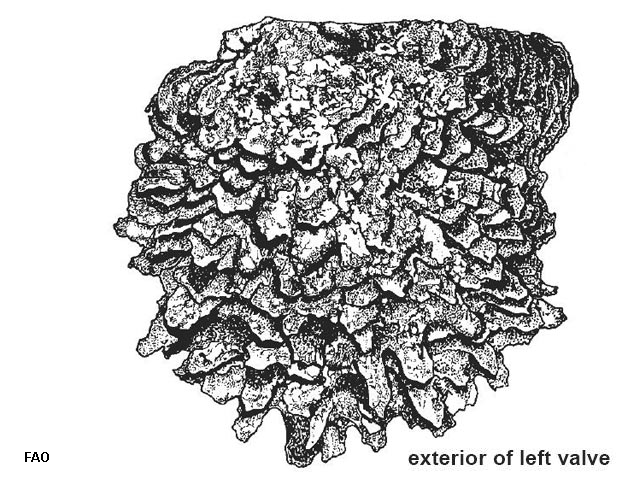| Margaritidae () |
| 30 cm ShL (male/unsexed) |
|
benthic; marine; depth range 0 - 60 m |
| Indo-West Pacific: from Nicobar and Andaman Islands to Melanesia; north to Japan and south to Queensland and Western Australia; Borneo and Moluccas. |
|
Shell rather thick and large (attaining 30 cm in length), subcircular in outline, with a short and ill-defined posterior ear which is not drawn out into a wing-like process. Anterior margin markedly protruding beyond the tip of anterior ear. Outer surface of valves, when not worn, covered with flattened, imbricating concentric scales bearing large and irregular, flat spines with blunt ends, roughly arranged in radial rows and projecting at shell margins. Hinge completely devoid of teeth. Colour: outside of shell uniformly fawn, sometimes with radial stripes of darker spots in umbonal region; then, ground colour in that region green, dark brown, or purple. Internal nacreous area highly lustrous, silvery with a variably extended golden border. Non-nacreous margin clear, of plain horny colour. |
| Mainly in clear water under the influence of currents. Often in dense colonies. Littoral and sublittoral to a depth of 60 m; most common from sublittoral at depths of 5 to 30 m (Ref. 348). On various bottoms, byssally attached to hard substrates at least in the young stages (Ref. 348). Inhabits a broad range of habitat, from sand, mud, gravel, seagrass beds, deep-water reefs, to near sponges, soft corals or whip corals. Filter-feeder (Ref. 101206). |
|
Not Evaluated (N.E.) Ref. 123251)
|
|
|
Source and more info: www.sealifebase.org. For personal, classroom, and other internal use only. Not for publication.

